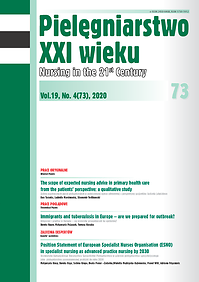Wiedza i umiejętności z zakresu osłuchiwania klatki piersiowej wśród pielęgniarek
DOI:
https://doi.org/10.2478/pielxxiw-2020-0020Słowa kluczowe:
osłuchiwanie, osłuchiwanie klatki piersiowej, badanie fizykalne, pielęgniarkiAbstrakt
WIEDZA I UMIEJĘTNOŚCI Z ZAKRESU OSŁUCHIWANIA KLATKI PIERSIOWEJ WŚRÓD PIELĘGNIAREK
Wprowadzenie. Wywiad oraz badanie fizykalne są podstawowymi elementami pozwalającymi pielęgniarkom ocenić stan zdrowia pacjentów. Umiejętność osłuchiwania klatki piersiowej w połączeniu z wiedzą anatomiczną i fizjologiczną daje szybką i niezawodną metodę rozróżniania i diagnozowania wielu chorób.
Cel. Celem przeprowadzonych badań była ocena wiedzy i umiejętności z zakresu osłuchiwania klatki piersiowej wśród personelu pielęgniarskiego.
Materiał i metodyka. W oparciu o założone kryteria doboru losowego do badań zakwalifikowano 51 przedstawicieli zawodu (41 kobiet i 10 mężczyzn). Ocenie poddano poziom wiedzy oraz umiejętności z zakresu osłuchiwania klatki piersiowej oraz samodzielność podejmowania tej czynności w pracy zawodowej. Wykorzystano autorski test wiedzy, kwestionariusz ankiety oraz trenażer SimScope 360-3400. Wartości p<0.05 uznano za statystycznie istotne.
Wyniki. 10% badanych wykazało brak umiejętności osłuchiwania klatki piersiowej, mimo, że u żadnego z badanych nie stwierdzono braku wiedzy w tym zakresie (p<0.001). Wraz z wyższym poziomem wiedzy poziom umiejętności badanych ulegał wzrostowi, a niższy poziom wiedzy warunkował niższy poziom umiejętności (p=0.049). W opinii badanych osłuchiwanie płuc i serca są czynnościami wykonywanymi wyłącznie przez lekarza.
Wnioski. Pomimo umiarkowanego poziomu wiedzy i umiejętności z zakresu osłuchiwania klatki piersiowej, personel pielęgniarski nie wykorzystuje technik badania fizykalnego w pracy zawodowej.
Bibliografia
1. Padykuła M, Czaja E, Pieczyrak-Brhel U, Kózka M. Znaczenie badania fizykalnego w pielęgniarstwie neurologicznym. Pielęg XXI w. 2017;4 (61): 46-51.
2. McElhinney E. Factors which influence nurse practitioners ability to carry out physical examination skills in the clinical area after a degree level module – an electronic Delphi study. J Clin Nurs. 2010;19 (21-22): 3177-3187.
3. Sarkar M, Madabhavi I , Niranjan N, Dogra M. Auscultation of the respiratory system. Ann Thorac Med. 2015;10 (3): 158–168.
4. Elder A, Japp A, Verghese A. How valuable is physical examination of the cardiovascular system? BMJ 2016; 354:i3309.
5. Secrest JA, Norwood BR, duMont PM. Physical assessment skills: a descriptive study of what is taught and what is practiced. J Prof Nurs. 2005;21 (2): 114-118.
6. Lont KL. Physical assessment by nurses: a study of nurses’ use of chest auscultation as an indicator of their assessment practices. Contemp Nurse. 1992;1 (2): 93–97.
7. Raleigh M, Allan H. A qualitative study of advanced nurse practitioners’ use of physical assessment skills in the community: shifting skills across professional boundaries. J Clin Nurs. 2017;26 (13-14): 2025-2035.
8. Regulation of the Minister of Health of 07.11.2007 regarding the type and scope of preventive, diagnostic, therapeutic and rehabilitation services provided by a nurse or midwife independently without a medical order. Journal of Laws of 2007 No. 210 item 1540..
9. Act of 15.07.2011 on the Profession of a Nurse and Midwife. Journal of Laws 2011 No. 174 item 1039.
10. The Regulation of the Minister of Health of February 28, 2017 regarding the type and scope of preventive, diagnostic, therapeutic and rehabilitation services provided by a nurse or midwife independently without a medical order. Journal of Laws of 2017 item 497.
11. Santos LA, Ferreira L, et al. Physical examination in nurses’ hospital practice. Research, Society and Development, Itabira, v. 9, n. 7, p. e132973794, may 2020. ISSN 2525-3409.
12. Maben J, Latter S, Clark JM. The theory-practice gap: impact of professional-bureaucratic work conflict on newly-qualified nurses. J Adv Nurs. 2006;55 (4): 465- 77.
13. Anderson B, Nix E, Norman B, McPike HD. An evidence based approach to undergraduate physical assessment practicum course development. Nurse Educ Pract. 2014;14 (3): 242-246.
14. Birks M, Cant R, James A et al. The use of physical assessment skills by registered nurses in Australia: issues for nursing education. Collegian. 2013;20 (1): 27-33.
15. Cicolini G, Tomietto M, Simonetti V et al. Physical assessment techniques performed by Italian registered nurses: a quantitative survey. J Clin Nurs. 2015; 24 (23-24): 3700-6.
Pobrania
Opublikowane
Numer
Dział
Licencja
Prawa autorskie (c) 2020 Autorzy

Praca jest udostępniana na licencji Creative Commons Attribution-NonCommercial-NoDerivatives 3.0 Unported License.




